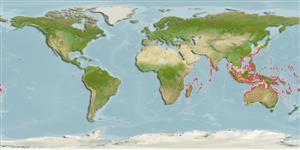Teleostei (teleosts) >
Blenniiformes (Blennies) >
Blenniidae (Combtooth blennies) > Salariinae
Etymology: Ecsenius: Greek, exenios, -os, -on = uncontrolled, immoderate.
Environment: milieu / climate zone / depth range / distribution range
Ecology
Marine; reef-associated; depth range 1 - 28 m (Ref. 5296). Tropical
Indo-West Pacific: Yemen (Ref. 54476) to northwest Australia, Philippines and Japan.
Size / Weight / Age
Maturity: Lm ? range ? - ? cm
Max length : 9.0 cm TL male/unsexed; (Ref. 559)
Dorsal spines (total): 12; Dorsal soft rays (total): 17 - 18; Anal spines: 2; Anal soft rays: 19 - 20. Anterior nostril with a long cirrus on posterior margin only. A longitudinal dark stripe on body often interrupted in larger specimens. In some populations, the black lateral stripe is sometimes present as a series of blotches (not observed in Indonesia) (Ref. 48636).
Adults inhabit shallow clear coastal to outer reef crests with rich coral growth to about 15 m depth (Ref. 48636, 9710). Often collected at depths less than 1 m in the northernmost parts of its range, but may occur more deeply (to 28 m) further south, and rarely more shallow than 5 m (Ref. 5296). Oviparous. Eggs are demersal and adhesive (Ref. 205), and are attached to the substrate via a filamentous, adhesive pad or pedestal (Ref. 94114). Larvae are planktonic, often found in shallow, coastal waters (Ref. 94114).
Life cycle and mating behavior
Maturity | Reproduction | Spawning | Eggs | Fecundity | Larvae
Distinct pairing (Ref. 205).
Springer, V.G., 1988. The Indo-Pacific blenniid fish genus Ecsenius. Smithson. Contrib. Zool. (465):134 p. (Ref. 5296)
IUCN Red List Status (Ref. 130435: Version 2024-2)
Threat to humans
Harmless
Human uses
Tools
Fatal error: Uncaught mysqli_sql_exception: Too many connections in /var/www/html/includes/speciessummary.lib.php:2004
Stack trace:
#0 /var/www/html/includes/speciessummary.lib.php(2004): mysqli->__construct()
#1 /var/www/html/summary/speciessummary.php(1812): checkRecordDisplayFBQuizV2()
#2 {main}
thrown in /var/www/html/includes/speciessummary.lib.php on line 2004
